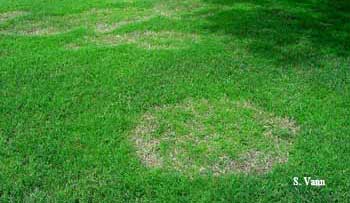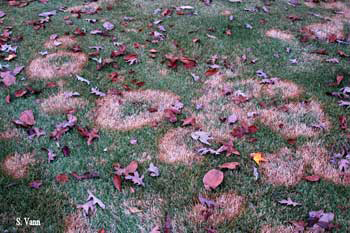Above the flood: recovering your lawn from heavy rainfall
By Lisa Lakey
For the U of A System Division of Agriculture
Fast Facts:
-
- Soggy lawns can survive, with preventative measures
- Saturation, thatch and aid fungal growth in lawns
(775 words)
LITTLE ROCK -- As rivers and lakes around the Natural State crest above flood stage due to heavy rainfall this spring, many Arkansans are finding rising waters on their lawns as well. With some areas of the state measuring more than 20 inches of rain in May alone, the weather has left many homeowners trying to reverse the damage left behind.

Mark Brown, a Pulaski County extension water conservation agent and turf expert with the University of Arkansas System Division of Agriculture, said excess rainfall can cause more problems for the homeowner than a soggy yard. But fear not. Residential lawns can survive a rainy spring if homeowners take preventative steps throughout the year and respond to floods proactively.
“First of all, we don’t have the greatest draining type of soil here,” Brown said. “As you get into the Delta and the farmland they have soil that drains a little bit better. Here, we have a lot of rocky, clay-type soils. The more amounts of clay you have, the worse it drains. Once that soil reaches the fill capacity and saturation point, it just can’t hold any more so you have a lot of standing water.”
Tree roots can also impact the soil’s saturation point, as well as providing a cover to keep the ground moist and preventing any standing water to be dried up by the sun. These spots of standing water can be breeding ground for grass-killing diseases.

“Bermudagrass lawns, Zoysiagrass, St. Augustine lawns, any of those types of grasses do not do well in extended periods of saturated soil,” Brown said. ‘The roots just don’t like being in the wet ground all the time. So what happens is they get weak, and any time they get weak it can introduce other things like diseases. For example, Zoysiagrass is really bad about getting what they call ‘large patch’ or ‘Zoysiapatch.’ It’s a fungus that attacks Zoysia and you can get it on other warm season grasses as well. You’ve seen brown circle areas in grass that start out as a little patch and grow. What it does is it starts to kill the grass from the inside out.”
Brown also said heavy fertilizing in the spring can contribute to fungus. The quick-release ammonium fertilizers being applied too early or too heavy can lead to thatch layer, an area just below the soil line containing dead grass and roots. When it becomes too thick, the excess water and fertilizer become catalysts for fungus.
While having better draining soil would eliminate many problems, there are steps homeowners can take to mend their soil. Lawn aerators and drainage systems such as French drains are effective, but can be costly and not feasible for the average homeowner.
“Proper maintenance is very important,” Brown said. “So a homeowner has to be aware of how much rain they’re getting, how their soil is drying, and things like that. If you do have standing water in your flowerbeds or your lawn then try to get it off somehow. Try to get as much sunlight through the canopies of your trees and down to the ground.”
Once fungus settles in it can be hard to combat but not impossible. A reputable lawn care technician can recommend the best course of action.
“If a homeowner can be very proactive they can get fungicide treatments from the lawn care guys to put on at a preventative rate through the spring and fall,” Brown said. “Once you get the disease, they can still spray with these fungicides at a curative rate as long as you know what it is, and they are putting the proper fungicide on it. You can get control of these diseases, and you can stop them.”
Once the disease is under control, grasses such as bermuda and zoysia will spread and fill back in the areas that were damaged. If the entire yard was affected, resodding might be the quickest way to rebuild the lawn.
If there is a drainage system in place, Brown recommends regular cleaning of the catch basin. Many problems involving excess water, such as blocked drains, can be prevented with a little proactive thinking. Brown points out that not everything can be controlled -- most of all Mother Nature.
“Sometimes you may be getting runoff from up the street,” he said. “You don’t know what’s going on up the street. We see a lot of weed problems that arise after flooding, because that flood water moves weed seeds. Water brings a lot of problems. Whatever problems were there last year, if proper control wasn’t put on them, they’ll come back this year. It’s a revolving door.”
For more information about landscaping, contact your county extension office or visit www.uaex.uada.edu.
The Arkansas Cooperative Extension Service is an equal opportunity institution. If you require a reasonable accommodation to participate or need materials in another format, please contact your County Extension office (or other appropriate office) as soon as possible. Dial 711 for Arkansas Relay.
Pursuant to 7 CFR § 15.3, the University of Arkansas System Division of Agriculture offers all its Extension and Research programs and services (including employment) without regard to race, color, sex, national origin, religion, age, disability, marital or veteran status, genetic information, sexual preference, pregnancy or any other legally protected status, and is an equal opportunity institution.
# # #
Media Contact: Mary Hightower
Dir. of Communication Services
U of A Division of Agriculture
Cooperative Extension Service
(501) 671-2126
mhightower@uada.edu
Related Links